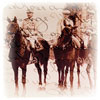Corporal Finlay Fairfax McLaren was born in Perth, Ontario, on January 22, 1891. Prior to his enlistment he had worked as a timber cruiser and had served in the militia with the 6th Regiment.
McLaren enlisted at Valcartier, Québec, on September 19, 1914, and sailed for England as part of the First Contingent on the S.S. Ruthenia in October of 1914. He was sent to France in February of 1915 with the 7th Battalion. The following April while fighting in the Second Battle of Ypres, in which the Germans introduced the use of poison gas as a weapon, McLaren was wounded by gunfire, gassed, and buried by a shell. As a result of his experience at Ypres, McLaren was diagnosed with neurasthenia, commonly referred to as shell shock, and was invalided back to Canada, where he was discharged from service in December of 1916.
Content notes:
The collection contains a small notebook that McLaren used as a personal record book and as a diary, with entries dated between February-May of 1915. Appearing in the notebook are references to some of McLaren’s fellow soldiers, many of them recorded as having been killed or wounded. Names and links to service files of those mentioned have been included below in cases where identification details allowed; among them is Lt. Boggs of the Lt. Herbert Beaumont Boggs Collection.
External links:
Cpl. Finlay Fairfax McLaren’s service record (Serv/Reg #16338) can be viewed/downloaded in pdf format through Library and Archives Canada.
Lt. Herbert Beaumont Boggs’ service record (Serv/Reg# not assigned), killed in action February 26, 1915.
Pte. James Boyle’s service record (Serv/Reg #21786), killed in action on or after April 24, 1915.
Pte. Albert Ernest Clapp’s service record (Serv/Reg #16291), killed in action February 27, 1915.
Pte. William Joseph Craig’s service record (Serv/Reg #15239).
Capt. Royce Coleman Dyer, MM, DCM, service record (Serv/Reg #445), died December 30, 1918, while serving with Imperial Army, Russia.
Pte. Harold Russell Guy’s service record (Serv/Reg # 17129), killed in action April 24, 1915.
Pte. Alfred Hodge’s service record (Serv/Reg #16905).
Pte. Charles McIntosh’s service record (Serv/Reg #1108).
L/Cpl. Michael O’Leary, VC, (Serv/Reg #3556) does not have a Canadian service record, but is honoured as a Victoria Cross Recipient at Veterans Affairs Canada.
Major Percy George Rigby’s service record (Serv/Reg # not assigned), killed in action March 10, 1915.
L/Sgt. Arthur Sparrow’s service record (Serv/Reg #16270), killed in action April 15, 1915.
Pte. Thomas Sutton’s service record (Serv/Reg #17173), killed in action February 26, 1915.
Sgt. William White’s service record (Serv/Reg #1089), killed in action March 14, 1915.




